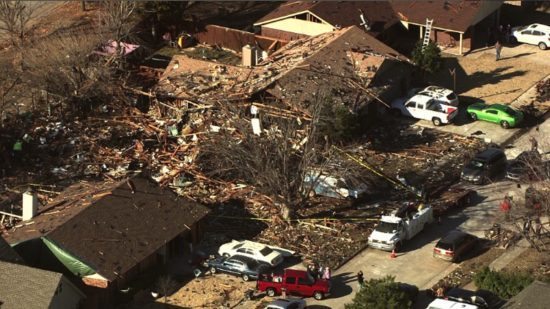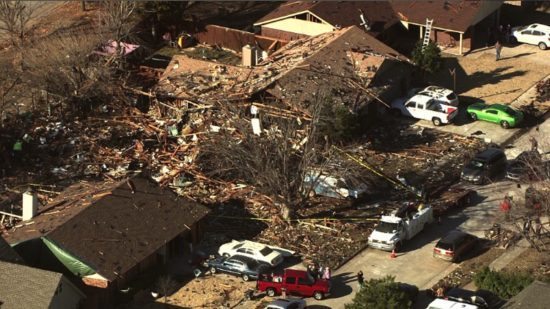Back in January, a house exploded early one morning in NW Oklahoma City courtesy of a faulty ONG gas line. Here's a Bob Moore Chopper 4 photo of the damage to refresh your memory:

Although one man suffered first and second degree burns after being blown out of bed (a.k.a. wake up call from Hell), no one died in the explosion.
After an investigation, the Corporation Commission announced the accident was due to a gas leak caused by "poor workmanship." ONG then conducted a review of their existing pipeline infrastructure, and identified 200 other sections of dangerous pipes that, I assume, could leak and blow up your house at any moment.
The ONG review got the attention of Matt Patterson with The Oklahoman. He asked the utility what other pipes were at risk of blowing shit up, because you know, that seems like something important we should know.
Check out ONG's answer...
A systemwide review of Oklahoma Natural Gas pipelines in the wake of a Jan. 2 explosion that damaged or destroyed dozens of homes in a northwest Oklahoma City neighborhood has identified more than 200 other sections of potentially dangerous pipeline.
The utility, which serves about 860,000 customers statewide, is in the midst of making needed repairs, but declined requests by The Oklahoman to identify the problem locations.
“For security reasons, we do not disclose specifics regarding our gas pipe infrastructure,” ONG spokeswoman Cherokee Ballard said in an email.
Hey, look at that! Cherokee Ballard! Along with Terri Watkins and Brooke (Osburn) Cayot, she's my favorite former news anchor who left the cutthroat world of TV journalism for the cushy, cozy, normal work schedule utopia of Corporate Communications. Congrats, Cherokee. Please add me to your press release list.
With that out-of-the-way, what the flying f*ck! Security reasons? What the does that even mean? According to Google, security is defined as "the state of being free from danger or threat." Sure, I'm a paranoid weirdo who's scared of moths, but knowing there's a chance that I live on top of a faulty gas line really doesn't help me feel free from danger or threat. OGN should have been honest and just chalked up the secrecy of the lines to "overly paranoid and cautious corporate reasons that don't make sense."
Seriously, why won't ONG tell us where the bad lines are located? I think it's something we all deserve to know. What does ONG think is going to happen? Are they worried some wacko is going to take a break from stealing copper and try to syphon leaking gas from one of the faulty lines? Do they think ISIS is going to destroy it? If that's the case, why doesn't ONG hire some security guards to watch the lines before crews fix them?
I'm not the only one who thinks it's ridiculous that ONG is hiding the locations from the public. The Oklahoman spoke with someone much more eloquent, smart and respectful than me:
Not revealing the affected areas while not uncommon, isn't productive, said Carl Weimer, director of the nonprofit Pipeline Safety Trust, a watchdog group based in Bellingham, Wash.
“I think in the context of high pressure transmission lines there are some legitimate security concerns,” he said. “But when you get into distribution lines that serve neighborhoods it doesn't make a lot of sense.”
He said in most cases, the public's best interests are served with transparency.
“It's well understood that there is a lot of pipe out there that is problematic in neighborhoods,” he said. “In some cases these pipes have been known to fail. So having a general sense of what's out there and what's not could reassure people about the risks in their own neighborhood.”
Among 60 operators nationwide with more than 10,000 miles of gas distribution lines, ONG ranked eighth in the number of significant incidents per million miles of pipeline in the last five years, according to the Pipeline and Hazardous Materials Administration, the federal agency charged with overseeing pipeline safety. The agency cited six significant incidents for ONG during that time frame.
Meanwhile, the corporation commission also fared poorly in a survey of pipeline safety agency websites conducted by the Pipeline Safety Trust.
The commission scored a ‘0' in areas like making inspection records available to the public, incident data, enforcement data and excavation damage data. Conversely, Arkansas earned a ‘3' across the board, the highest score a state can receive. Texas also scored higher than Oklahoma.
Wow. You're telling me the same three person regulatory commission that's allowed energy companies to turn Oklahoma into the California of man-made earthquakes also has a problem making sure our utilities are safe and don't randomly blow people up? Who would have thunk it.
Anyway, I guess we should all get ready to play a game of gas line roulette over the next, oh, 20 - 30 years. Based on how long it takes ONG to turn your gas on when you move, I have a feeling these repairs will take awhile.






